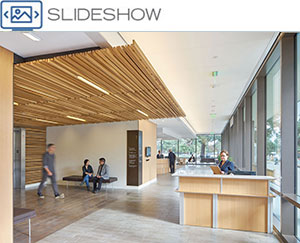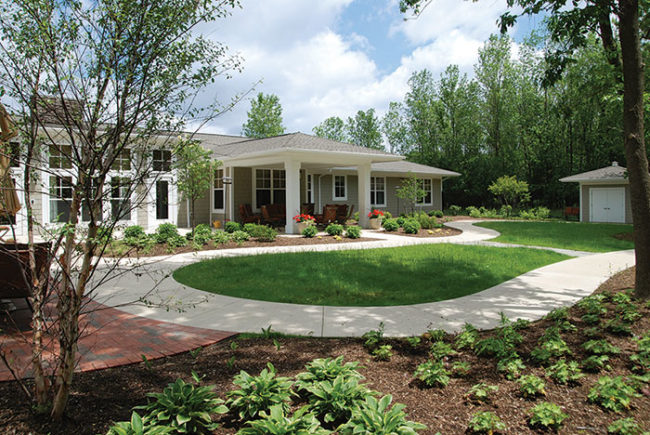
View "Outpatient facilities embrace Lean design" Gallery
A number of health care trends are converging at the neighborhood clinic. For one, advances in health care continue to expand what’s possible in the ambulatory care environment. “Nowadays in ambulatory care, what we do in the outpatient arena is what we used to do 10 years ago in an inpatient setting,” says Chris Backous, faculty member at the Virginia Mason Institute, a nonprofit education and training corporation affiliated with Virginia Mason Medical Center, Seattle.
As ambulatory care has flourished, the U.S. health care market has focused increasingly on efficiency and the patient experience. Health systems are building ambulatory care facilities throughout their communities, rather than just the main hospital campus — patient convenience and a health care organization’s visibility in the community are now key factors in choosing ambulatory care sites. “The approach is very different from the acute care mindset,” says Kyle Marden, ACHE, ASHE, LEED AP, managing director of ambulatory care, for real estate services and investment firm CBRE Group Inc., Los Angeles. “It’s changing from that traditional on-campus mentality to off-campus.”
Also in this article: |
| Perfecting patient flow and experience |
| Streamlining steps in outpatient facilities |
|
|
To make their facilities as efficient as possible, many health care organizations are following Lean methodology to maximize value and minimize inefficiency in design, construction and operations. Lean facilities are important for two reasons, explains Craig Comish, chief operating officer, CARTI Cancer Center, Little Rock, Ark. “The first is patient convenience. If you don’t have an efficient workflow process, you will have patient satisfaction issues,” he says. “Obviously, the other component is that we understand one immutable fact, and that is that every year they’re going to pay us less to do more. And so, if we don’t create the efficiencies from an operational standpoint that allow our staff to be optimally efficient in the delivery of care to those patients, then we, by definition, are designing a facility that will not assist us in our mission of improving quality at the same time we improve cost-effectiveness.”
Strategic benefits
Today’s freestanding ambulatory care facilities range from storefront clinics to specialty care centers. “Health systems are building more sophisticated buildings off-site. They’re not just doctors’ offices,” says Andy Jarvis, AIA, LEED AP, principal and health care design practice leader in the New York office of EwingCole. “The idea, of course, strategically, is to take more and more complex care away from the acute care hospital.” This allows the hospital to focus on the most advanced cases.
Off-site ambulatory facilities also can make health and wellness services more accessible to patients. Saul Jabbawy, director of design, EwingCole, says that for many families, getting to suburban clinics operated by the Children’s Hospital of Philadelphia (CHOP) means “[they] have maybe an hour, hour-and-a-half experience rather than half a day or more taking a child to the center of the city.” The off-campus setting takes away the anxiety of going to the hospital, he adds.
CHOP recently built ambulatory surgery and specialty care centers in King of Prussia, Pa., and Brandywine Valley, Pa., to collocate the hospital’s existing specialty care practices and expand its regional ambulatory care services. Each multispecialty clinic functions as “a one-stop shop,” says Lynne Tracy, AIA, senior project manager, CHOP. “You could go to ortho, you could do your therapy there, you could also have your operation there. There are multiple services provided in one location for a patient who might have to go to two or three locations, typically.”
IN BRIEF |
|
• As ambulatory care has grown, so have attempts to streamline its facilities. • Lean design and process standardization are helping organizations to achieve this. • After a facility is built, however, processimprovement remains a continuous journey. |
A large expanse of glass along the front of each new CHOP outpatient building provides natural light, outdoor views and wayfinding cues. Brightly colored accents, a signature element of CHOP’s main hospital, place the buildings clearly within the system’s design vernacular. “We looked at some of the ways we could keep that language going between the main hospital and the off-sites. We want to tie it all back to the main mothership,” Tracy says.
The entire northern façade of the King of Prussia facility is clad in glass curtain wall, patterned with bars of color. To suit the historical context and smaller scale of the Brandywine Valley facility, this building’s design features colored bars applied to brick, stone and glass. CHOP “has an intelligent approach of keeping key elements of the brand but allowing them to morph in relationship to the site,” Jabbawy says.
Efficient clinical space
Aurora Health Care, Milwaukee, built approximately 75 greenfield ambulatory care facilities and 50 expansions or renovations in eastern Wisconsin based on a modular, scalable prototype clinic design developed with Hammes Co., also based in Milwaukee. Mike Scholl, regional vice president, Hammes Co., says, “By the time we were done, Aurora definitely had a brand identity in these markets, because of the consistent look of the buildings from the outside and the consistent level of service that the continuity of this design provided.”
You may also like |
| Improving patient throughput |
| A new generation of ambulatory designs |
| Eight ambulatory models of care |
| Efficient ED designs |
|
|
Lean design, which emphasizes standardization, streamlines project development. Not having to reinvent a clinic design entirely for each new location gives health care organizations a speed-to-market advantage, more predictable construction costs and the chance to standardize materials from site to site. In addition, standard clinical modules adjust well to operational changes over time, says Dave Connolly, senior vice president, Hammes Co.
Health care organizations are standardizing clinical spaces within buildings and across their institutions. “The reason is, they are now having their staff travel from location to location,” says Mary Frazier, AIA, LEED AP, Six Sigma Green Belt, principal, EwingCole. A standard clinic module can support a variety of specialties and is easy for people who work at multiple sites to navigate.
At Memorial Sloan Kettering Westchester in West Harrison, N.Y., clinic rooms are standardized at 10 feet by 12 feet, the same size as an office or infusion room at the facility, to give the building maximum flexibility as needs change.
The clinic rooms are designed for efficient, comfortable care. They are built for both exams and consultations, so patients and physicians don’t have to move to another room for a consult. Each room includes a table where patients and caregivers can sit and talk eye-to-eye; the tabletop is made of whiteboard material to aid discussion. A nearby computer monitor is mounted on an arm that can be positioned as needed to review information or moved out of the way. A demountable panel behind the monitor will enable the health system to update technology without cutting into the wall. In the clinical zone of the room, demountable millwork houses a handwashing sink and stores trash, sharps, soiled linen and daily supplies. An exam chair allows patients to sit upright or recline. The room’s patient zone includes a bench where patients and family members can be seated, as well as a place for patients to hang their clothes.
At many new off-site clinic facilities, staff workspaces are separated from patient circulation routes in areas designated “off-stage” and “on-stage” in the design. “It really decreases a lot of wasted motion and a lot of chaos in the practice when you don’t have all those flows mixed together,” says Lindsay Gainer, executive director, clinical services and innovation, North Shore Physicians Group, Peabody, Mass.
The off-stage staff areas at North Shore Physicians Group’s urgent care center in Danvers, Mass., feature team workspaces called “flow stations,” where physicians, nurses and allied health professionals work side by side. “That really facilitates communication [and] really limits the wasted motion and the wasted time,” says Gainer. Exam rooms at the clinic have two doors, one leading to the staff work area and the other to the patient corridor.
Barn-style doors are useful in this type of design because they require less floor space than swinging doors, notes David J. O’Brien, director of strategic planning, Anderson Brulé Architects Inc., San Jose, Calif. He adds that some clinics are building extra deep supply walls between the staff area and the exam rooms; similar to hospital nurse servers, these supply walls open on both sides, so a person can stock them without entering the exam room. Switching from built-in cabinets to mobile carts is another way clinics are handling supplies efficiently.
“Rather than having to stock every room with all the specialty items, [clinics] can reduce their inventory by stocking specialty carts that basically move from room to room. It gives them maximum flexibility and also helps them manage their inventory,” says Lauren Janney, EDAC, LEED AP, associate, Shepley Bulfinch, Boston. Maintaining supplies at appropriate par levels at the point of use, so people don’t have to run back and forth to a central supply closet, is a huge part of efficient clinic design and operations, Gainer says.
Waiting is another type of inefficiency that Lean designs and operations strive to reduce in the off-site ambulatory care environment. The first floor of the Stanford Neuroscience Health Center in Palo Alto, Calif., features a centralized registration area to streamline registration procedures.
“Many of these patients have multiple appointments. The check-in process for each appointment can be pretty time-consuming,” says Rachel DeGuzman, licensed architect and director of planning, design and construction for Stanford Health Care, Palo Alto. The centralized system allows patients to check in once and receive a printed itinerary for the day. The itinerary includes a pass patients scan when they arrive on the floor for each appointment. A staff member then comes out to greet the patient and escort him or her back into the clinic space.
At Memorial Sloan Kettering Westchester, phlebotomy services are positioned near the main entry. Jarvis explains that at the organization’s previous cancer centers, patients would go first to the chemotherapy and infusion area to have their blood drawn, wait for testing to be completed and only then continue with their exams. “Memorial Sloan Kettering realized, ‘Why not put the blood draw up at the front door?’” he says. Now people can have their blood drawn on arrival, so by the time they get to an exam room or treatment area, the lab results are already available. “It was a simple realization of where you put it in the building to improve the flow,” Jarvis says.
The CARTI Cancer Center has five distinct entrances designed for different patient types, depending on the services they’re receiving: radiation therapy, screening radiology, diagnostic radiology, medical oncology or new patient services. “What that allows us to do is to split those flows of patients and not have a bottleneck in the physical environment,” Comish says.
Marvina Williams, R.N., Lean Black Belt, senior associate, Perkins+Will, says, “Every health care system that is doing a building should utilize Lean methodology.” Not only does the process help people design efficient operational workflows and the facilities to support them, it stresses continuous improvement, she says.
Rebecca Flink, practice leader, advisory services, Hammes Co., says, “If you take a look at Lean as a philosophy, it’s based on two very significant principles. One is continuous process improvement and the other one is respect for people.”
“It’s exciting,” says Connolly. “You’re always looking to improve the care environment, to get people to be more efficient, to get it more Lean, so that they can focus on the time they have with the patient.”
Amy Eagle is a freelance writer based in Homewood, Ill., who specializes in health care-related topics. She is a regular contributor to Health Facilities Management.





